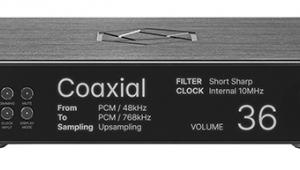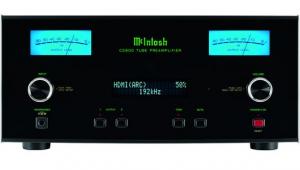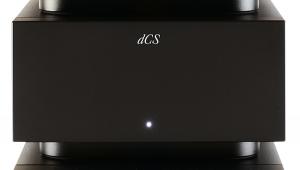Musical Fidelity MX-DAC USB DAC

 One of a trio of small but substantial add-ons, the MX-DAC joins Musical Fidelity's partnering MX-HPA headphone amp and MX-Vynl phono stage. Is this another steal?
One of a trio of small but substantial add-ons, the MX-DAC joins Musical Fidelity's partnering MX-HPA headphone amp and MX-Vynl phono stage. Is this another steal?
Imagine the dilemma when Pro-Ject acquired Musical Fidelity: the overlap with the former's Box range and the latter's MX models created an in-house rivalry in the 'affordable audiophile' sector. Both produce pint-sized ranges with matching phono stages, headphone amps and – of relevance here – beer-budget DACs. Musical Fidelity's MX-DAC, at £499, is a direct challenge to Pro-Ject's Pre Box DS2 Digital [HFN Nov '17] and a few others in the family, but the lineups are distinctive enough to cause no sleepless nights.
Let's dispense with the most important variance: sonic character. They are voiced slightly differently, so I anticipate numerous A/B comparisons between them and others from Cambridge Audio, Chord Electronics, iFi Audio and the like, as well as pocket-money USB DACs such as AudioQuest's DragonFly Cobalt [HFN Oct '19], which exceed any expectations relative to their price brackets. What the MX-DAC offers the music lover with a limited budget is a full complement of inputs, sufficient features, luxurious styling and feel... but above all, genuinely astonishing sound.
Captain Marvel
Before getting anywhere near to a conclusion, I must state that this is now my preferred DAC, cost-wise, between thumb-drive-encased USB DACs and circa-£1200 champions such as the Mytek Liberty. Thus it's best to tell you what the MX-DAC doesn't do, things which, for example, the Mytek Brooklyn DAC+ (my reference at, admittedly, more than 4x the price) offers.
The MX-DAC has no remote nor volume control to allow it to serve as a preamp, no cool display, no analogue input, no phono stage, and no headphone output. It is purely a DAC – and that's why it's so cost-effective. Thoughts of fiscal incentives soon disappear. You run your hand over the matte silver finish, noting the clean lines, admiring the chamfering and the fluted sides of the extruded case. You flick the positive-feel on/off toggle, tap the buttons with their crisp action. You observe the high-quality hardware at the back, including XLR balanced outputs, and then you cannot but marvel that all this is delivered in a sub-£500 DAC.
Because of this, the MX-DAC isn't just aspirational: it's actually an enabler for future upgrades elsewhere in one's system, moves that it will survive handily, as I found after inserting it into a system with significantly higher-end Audio Research and Wilson Audio elements.
Across the front are enough controls and LEDs to ensure that buyers-on-a-budget never feel deprived. At the left you find the on/off toggle, below LEDs indicating power-on and signal lock. Next are six LEDs to identify sampling rates from 44.1kHz to 192kHz, followed by two for DSD activity. The right-hand half of the fascia contains LEDs to indicate which of two filters has been selected – and I found the effects barely discernible, so I did not spend too much time worrying about them – followed by five LEDs to identify the selected input. Last are buttons for choosing inputs and 'filters'.

Inputs And Sources
Musical Fidelity has managed to fit every type of digital input into a unit measuring just 220x220mm (including the sockets) bar I2S and Ethernet, the latter typically the preserve of costlier solutions. Arranged left-to-right are XLR balanced and RCA line level outputs, a USB-B input, two each of RCA coaxial and Toslink inputs, the latter with built-in flaps so no worrying about misplacing those awful plugs of yore. Last is the mains input for the 5V/2A wall-wart. As you can imagine, the MX-DAC can be up-and-running without getting near the instruction manual if it isn't your first (digital) rodeo.
For assessing USB, I fed it signals from a desktop Mac computer, using Fidelia and Audirvana Plus software, the in-built Apple players and, in deference to the increasing number of hi-fi enthusiasts who now 'stream' their content, my catalogue of music files stored in the vastness of the amazon.co.uk cloud. I also used a Samsung BD-H5100 Blu-ray player (bought for playing US Zone A discs), which has HDMI as its main output, but also offers coaxial digital. A Sony BDP-S370 BD player was employed too, but regardless of which source I used, the 192kHz LED on the front of the Musical Fidelity MX-DAC stayed on most of the time.
![]() Kind Of Blu
Kind Of Blu
Using the Blu-ray audio disc from the anniversary box set of The Band's eponymous second album [Capitol 00602577842832], selecting the stereo 96kHz/24-bit PCM version, I was hit with one of those instant audio epiphanies. So natural, so ripe was the sound of the bass, so satin-y the upper frequencies, and so warm were the vocals that I knew I had hit on a track which could sell the MX-DAC even to the most inveterate of hi-fi snobs.In fact it was all about as unnerving as a sonic surprise gets.

























































